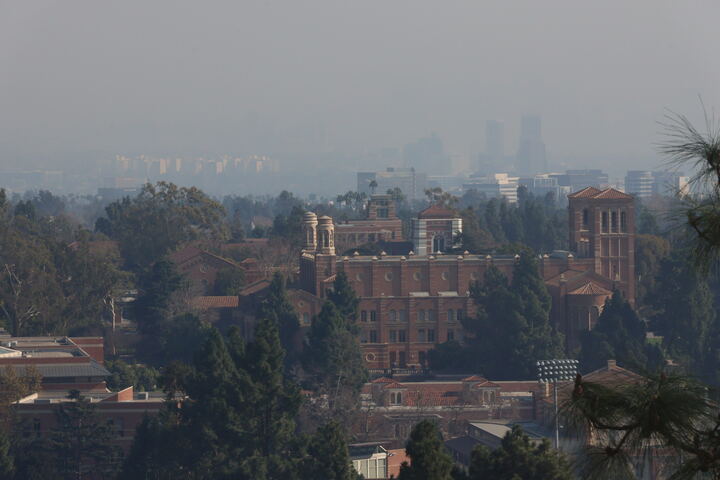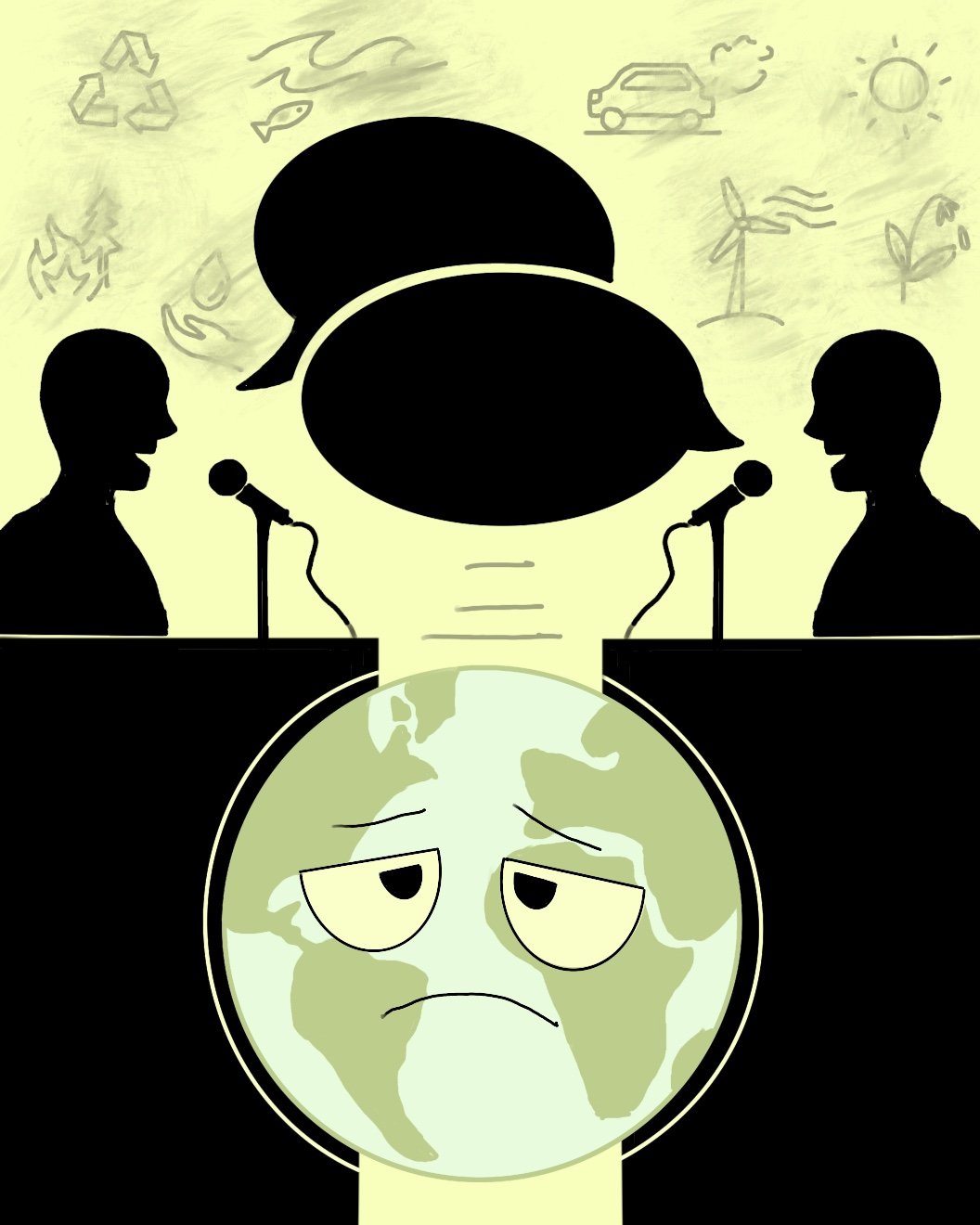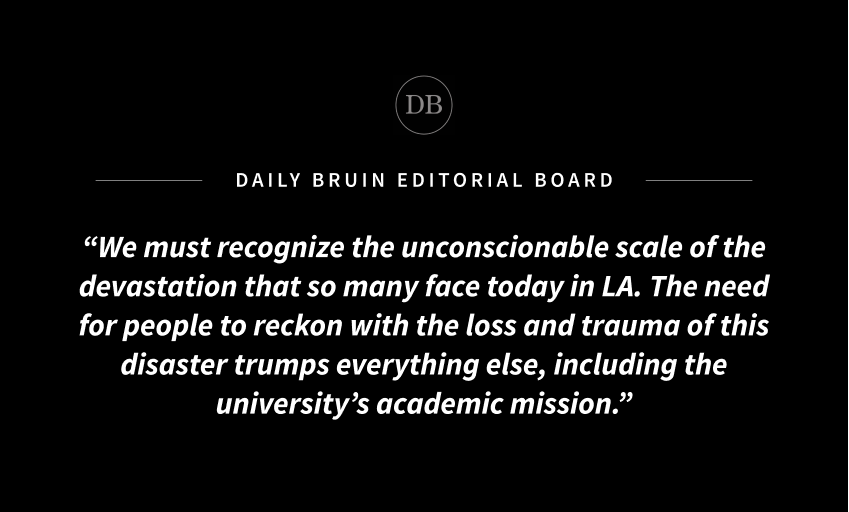Opinion: Air quality is difficult to measure. Prioritize your health and mask up.

A gray haze fills the air over Royce Hall, obscuring the Los Angeles skyline. (Selin Filiz/Daily Bruin)
By Micah Hoffman
Jan. 20, 2025 2:18 p.m.
This post was updated Jan. 20 at 10:09 p.m.
Wildfires in the Pacific Palisades have burned over 6,000 structures, releasing toxic smoke that threatens Los Angeles residents’ health.
Although UCLA has approved in-person classes and assured students the air quality is safe, students must be vigilant about their health and cautious about air quality monitors. While campus is not directly in a fire-affected area, pollutants are highly mobile and can be easily carried by the wind.
Wildfire smoke doesn’t stay localized. Driven by intense Santa Ana winds, hazardous air pollution has already breached UCLA’s campus. Dr. May-Lin Wilgus, a pulmonologist with UCLA Health, said pollution from wildfires can impact areas 10 to 15 times larger than the actual fire.
This smoke contains a harmful mixture of particles and gases, including fine particulate matter, called PM2.5, which has been linked to numerous health issues, such as respiratory disease, cardiovascular problems, cancer and neurodegenerative diseases.
The lungs can easily absorb PM2.5, which then enters the bloodstream, making these particles a major concern for anyone near the fires. They are, however, just one component of the cocktail of pollutants released into the air.
For students and faculty with pre-existing respiratory conditions, such as asthma or chronic obstructive pulmonary disease (COPD), wildfire smoke can trigger severe health complications.
The impact of wildfire smoke raises serious concerns for vulnerable populations, said Dr. Christopher Cooper, a professor at the David Geffen School of Medicine at UCLA and a specialist in respiratory disorders including COPD, a condition that restricts airflow and causes breathing difficulties.
“There are a lot of young people who have unrecognized, undiagnosed or even ignored asthma,” said Cooper. “When they get a respiratory tract infection, they may not have had their lung function measured, so they don’t know whether it’s normal or abnormal.”
Cooper said that one of his primary concerns for UCLA students during the fires is undiagnosed asthma – but residents experiencing asthma are not the only Angelenos at risk.
Some residents have raised alarms about harmful substances like asbestos and lead paint, which can be released from homes – built with these materials before they were banned – that burned during the fires.
While these concerns are valid, many homeowners have already addressed these hazards in their homes. In California, lead and asbestos assessments or disclosures are required if homeowners plan to renovate or sell their homes.
Cooper stressed that the real alarm lies with the unknown toxins released from burning cars and household items.
“I’m not sure that asbestos is the thing we should be most worried about with these recent fires,” said Cooper. “What is more worrying is the toxins and the volatile organic compounds and the unknowns that come from burning household contents and automobiles and fuel.”
Considering the variety of materials burnt, PM2.5 particles are just the tip of the iceberg.
It isn’t just houses that burn – it is everything inside them. Burning common household items such as plastic and batteries releases harmful substances, including gases that can cause severe lung damage and carcinogens.
Yet, despite these risks, the air quality index in Westwood reads as relatively safe. According to UCLA‘s air quality website, campus air quality has largely fluctuated between “good” and “moderate” since the start of the fires, only affecting some individuals with heart and lung disease.
However, Yifang Zhu, a professor of environmental health sciences at UCLA, said that accurately measuring the wide range of pollutants for the AQI is far from straightforward.
“Given the current fire, there’s just so many different things that burned, and it’s really hard to really understand all the pollutant types,” Zhu said.
Only five major pollutants, including PM2.5, are measured by AQIs from the U.S. Environmental Protection Agency. These represent only a fraction of what is actually in the air, Zhu said. Many toxic substances, particularly those released from burning household items, go undetected.
Ash particles are often too large for air quality instruments to detect, according to the South Coast Air Quality Management District, which regulates air quality in LA. As a result, a “green” assessment of air quality can provide a false sense of safety during and after wildfires.
“There’s maybe thousands of different chemicals in the air right now,” Zhu said. “And so whether you know to what extent the AQI can fully capture the smoke impact – I think that really has to be interpreted with caution.”
While websites such as Purple Air, IQAir and UCLA’s air quality website can provide a useful framework for determining air quality, they should not be the sole indicator of safety.
Right now, air quality is the most important factor to be aware of, said Rachel Connolly, project director for air quality and environmental equity research at the Luskin Center for Innovation.
“Air quality doesn’t only contribute to acute, short-term effects,” Connolly said. “It also contributes to long-term disease formation.”
To protect yourself from adverse health effects associated with PM2.5, Cooper suggested wearing an N95 mask and warned against paper and cloth masks.
“Those are not sufficient to protect in any way against fine particulate matter like PM2.5,” said Cooper.
Be prudent – do not rely on administrators to monitor health risks. Wear a proper mask, limit outside exposure and do not blindly trust air quality monitors. Your health and safety depend on the choices you make today.




